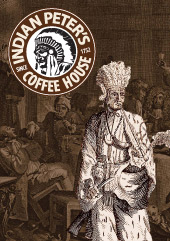Current shows:
Indian Peter's Coffee House
Reviews
The Scotsman,
Saturday August 24th 2013
(4 stars ****)
'A 1757 memoir by the subject of Mike Maran’s thoroughly enjoyable one man show, a real life doyen of Edinburgh’s enlightenment era heyday bore the splendidly unpithy title French and Indian Cruelty exemplified in the life and various viccistudes of fortune of Peter Williamson, who was carried off from Aberdeen in his infancy and sold as a slave in Pennsylvania.
‘Various viccisitudes’ is putting it mildly, as we come to learn, but not before Maran/Indian Peter, extravagantly costumed in feathered headdress, fringed leather coat and a kilt, has entertainingly laid out the wider historical and cultural context behind his life story.
The audience is welcomed as if to an evening salon at Peter’s eponymous establishment – which stood near Parliament House off the Royal Mile – and as if we too were among the leading lights of 18th century Auld Reekie, with the front row variously and flatteringly, cast as the likes of Adam Smith, Robert Burns, James Boswell, Robert Adam and a young Walter Scott.
The contribution each of these figures made to the Scottish capital’s then reputation as Europe’s great hotbed of new ideas is deftly outlined via these introductory greetings.
Maran portrays Williamson as quite the establishment figure in later life – urging Burns to write in English; stoutly extolling the virtues of the Union – while also weaving in a good many sly allusions to the present.
Skillfully accompanied and underscored throughout by live fiddle music and snippets of Gaelic song from Rona Wilkie (who alternates performances with Morag Brown), the narrative continues into Williamson’s own extraordinary biography.
This begins by highlighting the still little-known trade in kidnapped children, sold into slavery in America, that thrived in Aberdeen during this period, the 13 year old Williamson being one of hundreds, if not thousands, who suffered this fate.
After numerous reversals of fortune, including several years captivity by Native Americans, he eventually made it home and prospered in Edinburgh. (Among other achievements he went on to establish Britain’s first regular postal service.)
If anything, the show’s only real problem is a surfeit of material, both about its main subject and relating to the time in which he lived, such that both elements seem slightly constrained within a show of an hour’s duration.
But it is a fascinating theatrical history lesson, centred in the Festival city, which definitely leaves you wanting to know more.’
Sue Wilson
|

